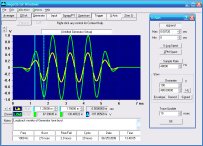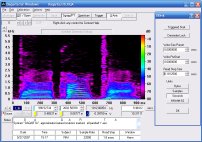![[LogoShip]](logo5.png)
Software for Windows
Science with your Sound Card!


Features:
Oscilloscope
Spectrum Analyzer
8-Channel
Signal Generator
(Absolutely FREE!)
Spectrogram
Pitch Tracker
Pitch-to-MIDI
DaqMusiq Generator
(Free Music... Forever!)
Engine Simulator
LCR Meter
Remote Operation
DC Measurements
True RMS Voltmeter
Sound Level Meter
Frequency Counter
Period
Event
Spectral Event
Temperature
Pressure
MHz Frequencies
Data Logger
Waveform Averager
Histogram
Post-Stimulus Time
Histogram (PSTH)
THD Meter
IMD Meter
Precision Phase Meter
Pulse Meter
Macro System
Multi-Trace Arrays
Trigger Controls
Auto-Calibration
Spectral Peak Track
Spectrum Limit Testing
Direct-to-Disk Recording
Accessibility
Data Logger
Waveform Averager
Histogram
Post-Stimulus Time
Histogram (PSTH)
THD Meter
IMD Meter
Precision Phase Meter
Pulse Meter
Macro System
Multi-Trace Arrays
Trigger Controls
Auto-Calibration
Spectral Peak Track
Spectrum Limit Testing
Direct-to-Disk Recording
Accessibility
Applications:
Frequency response
Distortion measurement
Speech and music
Microphone calibration
Loudspeaker test
Auditory phenomena
Musical instrument tuning
Animal sound
Evoked potentials
Rotating machinery
Automotive
Product test
Contact us about
your application!
AM Status Monitor
Beneath the AM Source control is the Status Monitor. This is a status display only, not a control. It shows the instantaneous modulation being computed at the time the display is updated (about 10 times per second default).
Note, however, that this is not the same as the actual modulation at the instant you view it. The samples are computed and sent to a buffer ahead of the time they are needed for output, so this monitor is actually more of a "preview". (You can set the buffer size with the Wave Block control in the Start Preferences dialog.)
This monitor is only useful for very slow modulation rates, where the values don't change too quickly to be read. This is true whether the source is a sine using the AM Mod Freq control, or a more complex waveform using stream modulation. At fast rates, the monitor is likely to jump around too much to be useful.
Also, if the modulator changes too quickly, the next update may catch it at a point in another cycle that doesn't seem to follow the prior value.
The values shown by the monitor are related to the AM Depth, but may need some interpretation. To see what is going on, try setting the Source to Sine and the modulation frequency to 0.1 hertz or less. Set Depth Mode to Peak. With Depth at 100%, the carrier amplitude slowly cycles between full-scale, where the monitor shows 100%, and zero output, which the monitor shows as 0%. (Remember that there is a time lag due to data buffering.)
Decrease Depth to 80%, and the swing is from full-scale down to 20%. As Depth is reduced further, the swing below full-scale is reduced as well; at a Depth of 10% the swing is only between 100% and 90%.
Increase Depth above 100% and the swing will go negative after it passes through zero; you'll see the carrier wave flip over. The amplitude swings from normal full-scale, through zero, to an inverted signal level equal to the amount that Depth exceeds 100%. For example, at a Depth of 120% the inverted signal reaches a maximum of 20%, and the monitor shows -20%. At a Depth of 200%, the output swing is between 100% and -100%.
See also Amplitude Modulation, Amplitude Modulation Dialog, Waveform Stream Controls.
- Back to AM Source
- Ahead to AM Depth
- Daqarta Help Contents
- Daqarta Help Index
- Daqarta Downloads
- Daqarta Home Page
- Purchase Daqarta
Questions? Comments? Contact us!
We respond to ALL inquiries, typically within 24 hrs.INTERSTELLAR RESEARCH:
Over 35 Years of Innovative Instrumentation
© Copyright 2007 - 2023 by Interstellar Research
All rights reserved